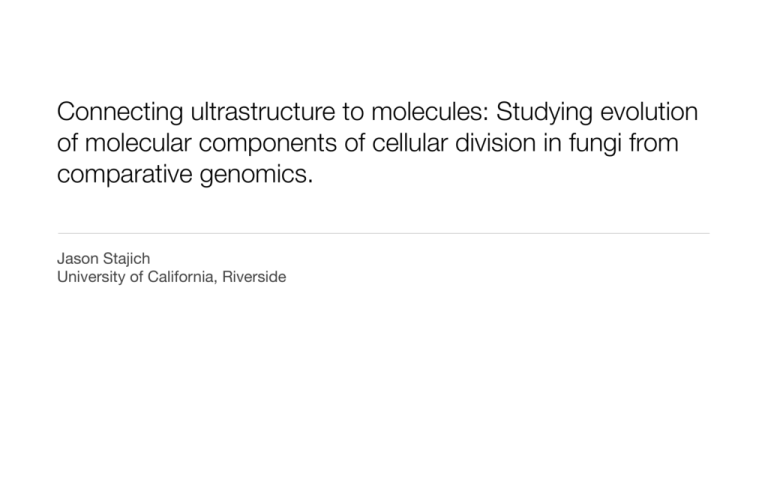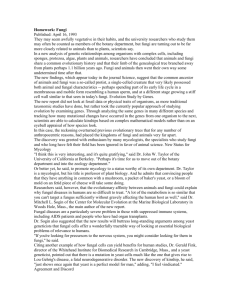Connecting ultrastructure to molecules: Studying evolution of
advertisement

Connecting ultrastructure to molecules: Studying evolution
of molecular components of cellular division in fungi from
comparative genomics.
Jason Stajich
University of California, Riverside
Evolutionary transitions in fungal cellular structure
<:,./,7
40(78(6(,
31(,.(6(,
$7/,6(,
$%&'()*('%+%,
,-./$
!"#$%%&
312/'%+%(02&(/,
C:,)/(&:,+%(02&(/,
$=:/%&7::=:,'FI%/1F
+%GG7'7./%,/7+F/%))=7)
$=&('(02&(/%.,
-./(0(*1/1('(02&(/%.,
>((*,5(02&(/%.,
E())F(GFG:,57::=0
?%&@A7::(02&(/%.,
;:(07'(02&(/,
<=&&%.%(02&(/%., !"#$%$&'()&*"
$%/(/%&F)*(',.5%,
/(F0%/(/%&F&(.%+%,F
9)/%:,5%.(02&(/%.,
45,'%&(02&(/%.,
H75=:,'F)7*/,
D,*1'%.(02&(/%.,
B,&&1,'(02&(/%.,
$7%(/%&F)*(',.5%,F/(F
7A/7'.,:F07%()*('7)
!"##
$%::%(.)F(GF27,')
+#)&'()&*"
<76%6(02&(/%.,
!###
"##
#
Stajich, Berbee, Blackwell, Hibbett, James, Spatafora,
Taylor. Current Biology. in press
Connecting evolutionary transitions to molecules
• Comparative genomics can help inventory the genes shared or missing between species
• Tracing the evolution from a flagellated, aquatic ancestor to filamentous and
• Using genome sequences from Chytridiomycota, Mucormycotina, and Dikarya fungi can
compare genes that are found only in Dikarya fungi and linked to the clade-specific
phenotypes
• 3 transitions illuminated
• Cellular division
• Cell wall composition
• Septa
Genome samples from fungi
Monosiga
Dictyostelium
Choanoflagellida
Caenorhabditis
Metazoa
Drosophila
Homo
‘Chytrid’
Batrachochytrium
Zygomycota
Spiromyces
Opisthokont
‘Chytrid’
Olpidium
Mucormycotina
Rhizopus
Fungi
Glomus
Glomeromycota
Puccinia
Basidiomycota
Cryptococcus
Coprinopsis
Schizosaccharomyces
Taphrinomycotina
Yarrowia
Saccharomyces
Saccharomycotina
Candida
Ascomycota
Morchella
Cochliobolus
Cladonia
Aspergillus
Pezizomycotina
Coccidioides
Magnaporthe
Neurospora
Fusarium
Tree Based on James TY et al. 2006.
Botryotinia
Nature.
100+ Genomes
Chytrid 5
Muromycotina 3
Glomeromycota (1)
Basidiomycota >30
Taphrinomycotina
4
Saccharomycotina > 20
Pezizomycotina
>60
http://fungalgenomes.org/wiki/Fungal_Genome_Links
Mucormycotina
B.dendrobatidis genes
shared with other fungi
Ascomycota
~50%
Via all-vs-all similar searches using
FASTP and 1e-5 E-value cutoff
Using genomes from 30 fungi and the
B. dendrobatidis genome
Identify the shared genes
Basidiomycota
~8800 genes in B. dendrobatidis
Differences between animal-like and fungal Microtubule
attachment points
• Transition from flagellated
cells with centrioles
microtuble
Microtuble
• Spindle pole bodies in nonattachment
flagellated fungi
point
http://remf.dartmouth.edu/
• Loss of flagellum coupled
with transition in basal
bodies?
Animal centriole
Thomas H. Gidding
• How did this transition occur?
Yeast spindle-pole body
Differences between animal-like and fungal Microtubule
attachment points
• Transition from flagellated
cells with centrioles
microtuble
Microtuble
• Spindle pole bodies in nonattachment
flagellated fungi
point
http://remf.dartmouth.edu/
• Loss of flagellum coupled
with transition in basal
bodies?
Animal centriole
Thomas H. Gidding
• How did this transition occur?
Chytrid centriole
Yeast spindle-pole body
.org on February 27, 2008
Centrioles in animals and chytrids are homologous structures
Cross-section of a rat kangaroo
(Marsupial, Animalia) centriole
region
Berns MW et al. J Cell Biol 1977
Chytrid zoospore cross section with
2 centrioles
Entophlyctis luteolus
Longcore. Mycologia 1995
Chytrid genome is missing some chromosome segregation
and mitosis related genes
• Missing genes in the B. dendrobatidis genome
• MSP3, KAR1, KAR2 for nuclear membrane fusion during karyogamy and Spindle-body
duplication
• SPC42 - central plaque component of spindle pole bodies
• CEP3 - essential kinetochore protein
• CIN2 - Tubulin folding protein
• REC8 for sister chromatid cohesion
• DASH Complex for kinetochores coupling during mitosis (10 genes)
Septa
• Septa allow for separation of cells, isolate
cytoplasm, allow for cellular differentiation.
• Regular septa in the Dikarya, but septa do
exist in some pre-Dikarya
Auriscalpium vulgare
(Agaricomycotina) hyphal
septum.
Celio et al. Mycologia. 2007
• Septa observed in the Kickxellomycotina
(Coemansia)
• All 6 septin genes identified in Aspergillus
are found in early fungi (B. dendrobatidis)
A. nidulans (Pezizomycotina)
Coemansia
septum and woronin body.
Momany et al. Mycologia. 2002
Stajich et al. Current Biol. in press
Fungal cell wall changes
Yeast Cell Wall
Selitrennikoff CP, AEM 2001
Cell wall changes from Early fungi
• Looking at the proteins known to make up cell wall in well studied yeast
Saccharomyces cerevisiae
• Identified series of genes missing in Bd including major components of the 1,3-β
glucan biosynthesis pathway (FKS1) and many of the KTH transporters
• With collaborators (JP Latge) we showed through a simple cell wall composition assay
• Missing β(1,3)- & β(1,6)-glucans but contain β(1,4)- glucan: cellulose.
• Few "higher" fungi have been documented to have cellulose in cell walls
(Ascomycota)
• Bd is much less sensitive to Enchinocandin drugs which target FKS1
• Does gain of genes to make β(1,3)-glucan and/or loss of cellulose represent one of the
major transitions from aquatic to terrestrial lifestyles for fungi?
Connecting molecules to evolutionary transitions
• Nuclear division changes
• Basal body, centriole loss coupled with loss of flagellum
• What happened first? Where did spindle-pole body genes evolve from - duplication or
novel gene creation?
Did some of flagellum & basal body genes evolve new functions?
• Multicellular development
• Differentiation of multicellular tissue, septation, and signaling
• Cell wall changes
• 1,3 Beta-glucan and 1,6 Beta-glucan synthesis evolved after Chytrid divergence
• Was this a necessary transition with the aquatic to terresterial life changes?
Identifying an ancient photoreceptor
• Fungi have some light sensing molecules but no known rhodopsins
have been cloned.
• Rhodopsin molecule implicated in zoospore phototaxis in Allomyces
(by comparing wavelengths where cells responsed)
• Sequence similarity identifies a candidate 7-transmembrane protein,
but has insertion found in both Bd and Allomyces (draft genome).
insertion?
Transitions inferred from genome comparisons
Monosiga brevicollis
AFTER CHYTRID SPLIT
Loss of:
• Flagella, centrioles
• 1,4 Beta-glucan
synthesis
Gain of:
• STE50 adaptor
• Some glucan synthase
and transferases
• Rhodopsin-like
7TM
Batrachochytrium dendrobatidis
Rhizopus oryzae
Cryptococcus neoformans
Coprinopsis cinerea
Laccaria bicolor
Dikarya
IN DIKARYA, Gain of:
• Spindle-pole bodies
• 1,3 Beta glucan synthase
• Thiamine biosynthesis
• STE3 pheremone receptor
• DASH complex
• KTR mannosylphosphate
family
Loss of:
• Chitosanase
Homo sapiens
Schizosaccharomyces pombe
Saccharomyces cerevisiae
Neurospora crassa
Aspergillus nidulans
Coccidioides immitis
Thanks
John Taylor & Laboratory (Univ California, Berkeley)
Mary Berbee (Univ British Columbia)
UC Berkeley Imaging facility & Barbara Waaland
Miller Institute
B.dendrobatidis sequencing
Joint Genome Institute & Broad Institute
http://fungalgenomes.org/blog
New research starting at UC Riverside
• Interested in research in fungal
genomics?
• Evolution of fungal development
• Post-transcriptional gene regulation
and small RNAs
• Fungal cell evolution in early
diverging chytrid and ‘zygomycete’
fungi
• Bioinformatics and genome informatics
of fungal comparative genomics







